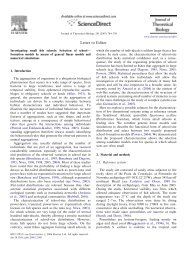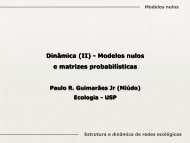SUPPLEMENTARY INFORMATION - Paulo R. Guimarães Jr.
SUPPLEMENTARY INFORMATION - Paulo R. Guimarães Jr.
SUPPLEMENTARY INFORMATION - Paulo R. Guimarães Jr.
Create successful ePaper yourself
Turn your PDF publications into a flip-book with our unique Google optimized e-Paper software.
5956 <br />
BIRDS<br />
COLEOPTERA<br />
Pitkin, B. (ed.). (2003). The Coleoptera Collection and Card Index. World Wide<br />
Web electronic publication. /research-curation/projects/coleoptera/<br />
http://internt.nhm.ac.uk/jdsml/entomology/collections/beetles/index.dsml<br />
[accessed between February 20 and March 10, 2006]<br />
Bird phylogenies were built employing several sources of information, attempting to<br />
assemble our hypotheses according to the best information on avian relations currently<br />
available. Relations among major avian groups followed Fain and Houde (2004),<br />
whereas relationships within passerines were based on Barker et al. (2004) and Cibois<br />
and Cracraft (2004). Relations among a small group of new world tyrants (a total of 7<br />
spp. in 3 different communities) followed Birdsley (2002), which was the only<br />
phylogeny not based on DNA sequence data (phylogenetic hypothesis based on<br />
morphological and behavioral characters). More detailed phylogenetic information for<br />
some groups was obtained from the following references:<br />
PASSERINES<br />
Oscine families (songbirds) – Spicer and Dunipace (2004)<br />
Fringillidae and Emberezidae – Burns et al. (2002, 2003), Yuri and Mindell<br />
(2002) and Ericson and Johansson (2003)<br />
Turdidae – Klicka et al. (2005)<br />
Trogonidae – Johansson and Ericson (2005)<br />
Tyrannids – Chesser (2004), Johansson et al. (2002) and Birdsley (2002)<br />
Corvids – Ericson et al. (2005) and Cicero and Johnson (2001)<br />
Paradisaea – Nunn and Cracraft (1996)<br />
Meliphagoidea – Driskell and Christidis (2004)<br />
Paridae – Gill et al. (2005)<br />
Sylviidae and Muscicapoidea – Bohning-Gaese et al. (2003)<br />
Icterus genus – Omland et al. (1999)<br />
NON-PASSERINES:<br />
Columbiforms – Johnson (2004)<br />
Toucans – Barker and Lanyon (2000), Weckstein (2005) and Eberhard and<br />
Bermingham (2005)<br />
Woodpeckers – Webb and Moore (2005)<br />
BRANCH LENGTH DIAGNOSTICS<br />
We employed the diagnostic test proposed by Garland et al. (1992) to determine the<br />
statistical adequacy of different arbitrary branch lengths. This computes the correlation<br />
between the absolute value of each standardized contrast against its standard deviation





